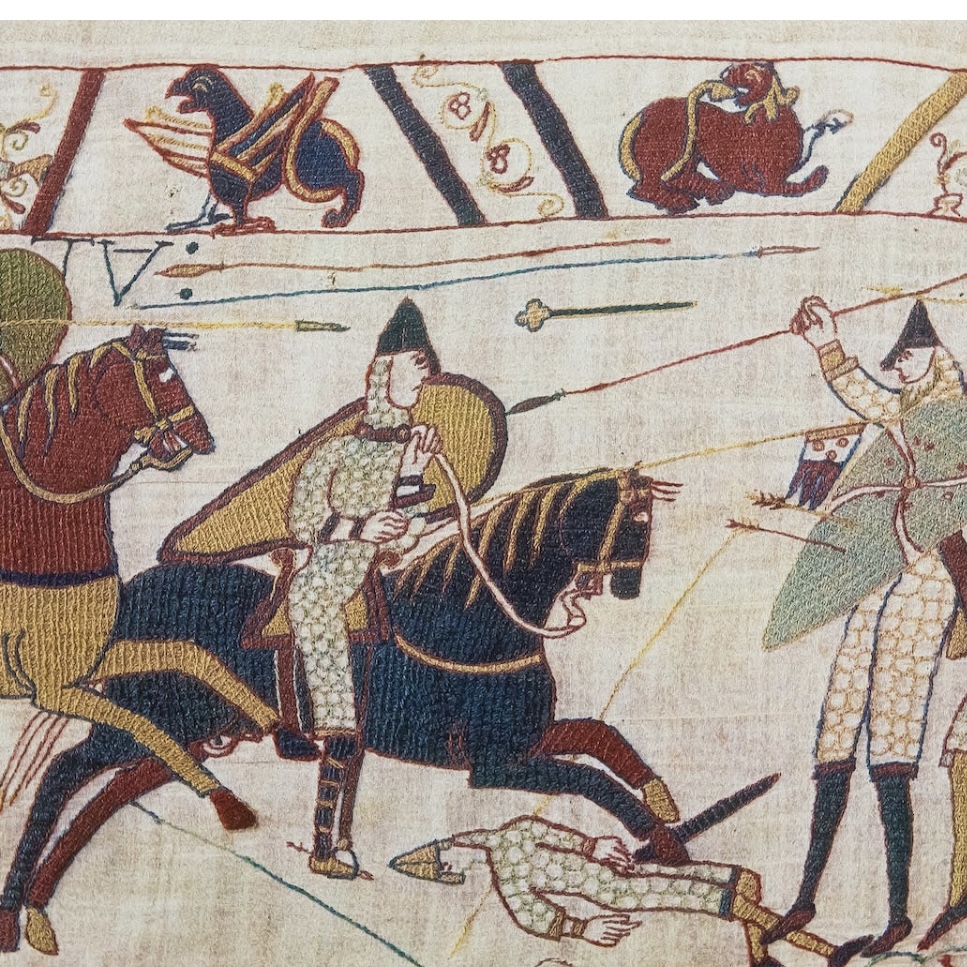
A few years ago my husband’s college roommate Ken invited us to join him on a trip to Normandy. I had a bit of a hassle replacing my missing travel documents, but eventually all was resolved. (See The Purloined Passport)
We flew first to Paris where we visited with family and friends, then rented a car and drove to Caen where we met Ken, and for the next several days immersed ourselves in World War II and D-Day history. And as we expected, we found our time in Normandy both very educational and very emotional.
Towards the end of our stay the two men decided to go to another of the several Normandy museums in the area but I wanted to spend some time in Bayeux to see the celebrated tapestry, and so I went alone.
There I found the 230 foot long tapestry mounted behind protective glass and encircling the walls of the Bayeux Tapestry Museum. An excellent auto-guide took me through the 58 scenes, embroidered with colored yarn on the tapestry’s 9 linen panels.
Thought to date from the 11th century, the tapestry depicts the events leading up to the 1066 Norman conquest of England and the British King Harold’s defeat by Duke William of Normandy at the Battle of Hastings.
I was captivated by the tapestry – the pain-staking work of the artisans who wove it centuries ago; the imperative at the time to record the historic battle in art; and the story of how the tapestry survived and was preserved.
When we left France we took with us a clearer understanding of the events of WW II and what happened in Normandy, and I left with a deeper appreciation of my father’s part in the war. (See Captain)
And I also left with the story of another battle – one fought in Hastings ten centuries ago, and immortalized in the extraordinary work of art I saw in that lovely museum in Bayeux.
– Dana Susan Lehrman
This retired librarian loves big city bustle and cozy country weekends, friends and family, good books and theatre, movies and jazz, travel, tennis, Yankee baseball, and writing about life as she sees it on her blog World Thru Brown Eyes!
www.WorldThruBrownEyes.com




How lucky you were to see that tapestry, Dana. When we visited Normandy on a larger tour (about 100 people), we had a choice of some of the landing beaches or Bayeux. We chose the beaches (so we saw all of them, including where the British and Canadians landed), but I’m sure what you saw was equally as fascinating. Being a student of the British monarchy (even back to the start of it), I’m sure I would have loved this. Thanks for giving some details here.
Yes Betsy, it was lovely, so glad I went!
Interesting juxtaposition,, the long history of wars in Normandy, the evidence displayed for all to see, the lessons on how to avoid the next war not as clear. And yet documentation in art, in monuments, in history is important so we might learn.
Good point Khati, will we learn?
Someday we will live in a world where war and the rumors of war will be a distant stain on who we are. Either that or we will have blown up and disappeared. I still find your trip to Normandy and that breath-taking tapestry fascinating. It’s history as well.
Hoping so Patty, but we don’t seem to learn from our bloody history!
Hi, Dana. Thanks for sharing your experience of seeing the Bayeux Tapestry, something I’m sure most of us have not done. You’ve aroused my curiosity about it, but at my advanced age, I’ll doubt I’ll ever get back to France. Fortunately, the Tapestry can be seen in great detail, scene by scene, on the website of the Bayeux Museum, and that will satisfy not only my curiosity but of others as well. Below is the link
https://www.bayeuxmuseum.com/en/the-bayeux-tapestry/discover-the-bayeux-tapestry/explore-online/#explore
Thanx Fred! And so good to see you commenting on this week’s stories, and hoping you’ll be writing stories of your own again!
And thanx for the link, I will savor looking at the Tapestry again!
Dana: Thanks for sharing your experience and its personal meaning. I also want to thank Fred for the link to the tapestry. The artistic narrative of and memorial to this early battle asked me what we could learn from this art. The tapestry’s content included not only pictures of battle, but also of everyday activities and animals. It made me think of current memorials in comparison. Though not a tapestry, the WW2 monument in Washington D.C. cold have used some inspiration from the tapestry. D.C. was full of monumental steles. Another pattern would be to present the war not only in terms of the soldiers who were sacrificed, but also with statues of factories and workers who made the war possible. Additionallyh, the cost of the war was not only in human lives, but also in animal and ecological destruction–e.g. Tokyo, Hiroshima, and Nagasaki. The Bayeux Tapestry reminded me of the artistic representations in traditional Japan, where they included live women, and children. War is inclusive of all the members of society. Thus, I hope we can learn from the art of the Bayeux Tapestry.
Thanx Richard for your always insightful comments! Glad you enjoyed Fred’s link!
Very good, Dana! It’s amazing how a tapestry can make such an impact on you and others so many, many years later. But that’s art for you!
Yes Jim, amazing and wonderful isn’t it!
It sounds like an amazing experience. Wish I could have seen it.
It was Laurie, I didn’t expect it too be so impactful!
An interesting choice of art for impact. Although I enjoy going to museums with others, something special happens when I take myself in hand and go for my own art exploration. There’s also something special about seeing the source of an image such as the tapestry of the battle of Hastings. It was also significant that you combined that momentous history with a trip to another iconic battleground — Normandy.
Merci Chas!
Normandy was a deeply moving experience for me as well.
My wife is a huge fan of something called “The British History Podcast,” which is an EXTREMELY detailed recounting of British history from pre-Roman to WW-II. She is up to the Norman conquest. It seems that, even in a time when nasty behavior was the norm, Richard was an absolutely murderous, rapacious and genocidal SOB, and not all that good at anything but conquering.
Thanx Dave,
Normandy was moving indeed.
Hope Gina reads my Tapestry tale!